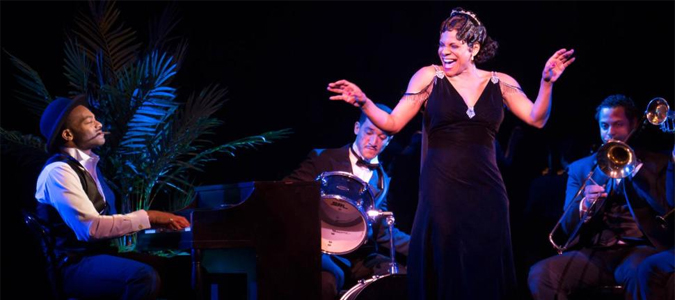

Shuffle Along
Opening Night: April 28, 2016
Closing: July 24, 2016
Theater: Music Box Theatre
In May 1921, the new musical “Shuffle Along” became the unlikeliest of hits, significantly altering the face of the Broadway musical, as well as that of New York City. By the time “Shuffle Along” stumbled into town after a back-breaking pre-Broadway tour, it was deeply in debt and set to open at a remote Broadway house on West 63rd Street. But with an infectious jazz score and exuberant dancing, “Shuffle Along” ignited not just Broadway, but all of New York City. Because of “Shuffle Along,” Uptown and Downtown met — and became one. The 2016 “Shuffle Along,” created anew by a remarkable constellation of artists, brings the original show back to glorious life, while simultaneously telling the heretofore unknown backstage saga of its creation — and how it changed the world it left behind.
BUY TICKETSREAD THE REVIEWS:
April 28, 2016
So just what is it, this tart and sweet, bubbly and flat, intoxicating and sobering concoction being dispensed from the stage of the Music Box Theater? “Shuffle Along,” which opened with a whoop and a sigh on Thursday night, has been suffering from an identity crisis in the weeks leading up to the announcement of the Tony Award nominations. It shares its name and most of its song list with a landmark musical from 1921, which means this production should qualify as a revival, right? (That’s what its producers, for strategic purposes involving a juggernaut called “Hamilton,” have argued.) But wait a minute. The latest version of this show, which features immortal songs by Noble Sissle and Eubie Blake, has a subtitle, dangling like an heirloom earring: “Or the Making of the Musical Sensation of 1921 and All That Followed.” So is this “Shuffle Along” old or new? The answer is emphatically … both, though not in the ways you might expect. That old-as-the-Rialto story line is — bear with me — what’s new in this “Shuffle Along,” the part written by Mr. Wolfe, and it’s what feels stalest. The book of the original “Shuffle Along,” by F. E. Miller and Aubrey Lyles, involved a mayoral campaign in a small town. The Broadway of the 1920s had no doubt seen similarly plotted shows. What made this one unusual was that its cast and, more startlingly, entire creative team were black. What made it a bona fide hit, running close to 500 performances, was the jaw-dropping virtuosity of its singing and dancing. Which is also what makes the reincarnated “Shuffle Along” one of the season’s essential tickets. As staged by Mr. Wolfe and Mr. Glover — and interpreted by stars who include Brian Stokes Mitchell, Billy Porter and the incomparable Audra McDonald — routines first performed nearly a century ago come across as defiantly fresh.
READ THE REVIEWApril 28, 2016
“Shuffle Along, Or the Making of the Musical Sensation of 1921” and All That Followed is a refreshing burst of energy, no caffeine necessary. With a cast that features Audra McDonald, Billy Porter, Brian Stokes Mitchell, Joshua Henry, and Brandon Victor Dixon (there are 16 Tony wins and noms between them), the jazzy musical boasts so much star power, at times it seems unfair to the rest of the Broadway circuit. Director George C. Wolfe and choreographer/tap dancer extraordinaire Savion Glover reunite for the first time in 20 years (1996’s “Bring in ‘da Noise, Bring in ‘da Funk”) for the musical centered on the real-life creative team behind the 1921 Broadway sensation “Shuffle Along.” Here, we meet playwrights F.E. Miller (Stokes Mitchell) and Aubrey Lyles (a phenomenal Porter), lyricist Noble Sissle (Henry) and composer Eubie Blake (Dixon). All four differ in personality (Porter’s flamboyant Lyles could come with his own Housewives-esque tagline: “I say what I want, when I want”), but share the same dream — to launch the first all-black love story musical on Broadway. And make it a success, at that. (In our Hamilton-iverse, this may feel like a no-brainer, but as we find out in the show, black actors who did even so much as hold hands on stage could be “tarred and feathered” after the curtain closed.)
READ THE REVIEWApril 28, 2016
The Broadway musical season that began with a Hamiltonian bang last August has now ended with another historical explosion, this one detonated by the playwright and director George C. Wolfe. His “Shuffle Along, Or the Making of the Musical Sensation of 1921 and All That Followed” is explosive not simply in the auditory sense, though the shattering artillery onslaught of Savion Glover’s choreography may ring in your ears (and change the way you think about the expressive potential of tap) forever. “Shuffle Along” is also explosive in the way a nuclear reaction is: Wolfe bombards a core of ideas about race and culture with a billion showbiz protons to produce both a gorgeous spectacle and a big, smoking crater where your former ideas of Broadway once stood. The spectacle first: Act One sensationally tells the story (most of it narrated by the four male principals) of how the original “Shuffle Along” arose from creative — but also racial — ambition. The Keith Circuit comic duo of F.E. Miller and Aubrey Lyles (Brian Stokes Mitchell and Billy Porter) wanted to break into the big time in an era when few shows by black artists made it to Broadway and fewer were successes. At an N.A.A.C.P. event in Philadelphia, they met the songwriting team of Eubie Blake and Noble Sissle (Brandon Victor Dixon and Joshua Henry), whose tastes ran less to the prevailing sound of operetta than to ragtime and Tin Pan Alley. The four men decided to turn a popular Miller & Lyles sketch called “The Mayor of Jimtown” into the book for their new collaboration, which would feature not only an all-black creative team but an all-black company, and, scandalous in that era, a romance involving the touching of all-black hands.
READ THE REVIEWApril 28, 2016
I’ve written here before that there is no artist in the theater today I admire more than George C. Wolfe, a writer and director blessed with the sharpest mind, the quickest wit, the wildest imagination and the fastest mouth in town. Without him, the theatrical landscape of the past 25 years would be inarguably flatter, whiter and duller. Consider his Broadway résumé alone: 1992’s “Jelly’s Last Jam,” the groundbreaking musical biography of nearly forgotten self-described inventor of jazz, Jelly Roll Morton, which Wolfe wrote and directed. 1993 and ’94’s “Angels in America,” the most influential and, in strong measure a result of his staging, entertaining play of the past quarter-century. “Bring in ‘Da Noise/Bring in ‘Da Funk” — his idea, script, staging and lyrics of a show that compressed the history and influence of African-American dance into yet another dazzlement of sight and sounds. “Caroline, or Change,” his second collaboration with Angels playwright Tony Kushner, this time a musical that spoke at the most profound, personal level to the fraught affair between African-Americans and Jews in the South during the first tremors of the Civil Rights era. This is a selective list and there are others, each ambitious and exploding with ingenuity, talent and risk. And one more essential ingredient, which is anger. I don’t know any other artist of Wolfe’s stature who has channeled rage into so brilliant and identifiable a catalogue raisonné. More often than not, that unsettling need to make a case, argue a point, declare and defend an unorthodox view has produced shows with energy, beauty and staying power. “Shuffle Along, or The Making of the Musical Sensation of 1921 and All That Followed,” falls squarely within that body of work and inspiration.
READ THE REVIEWApril 28, 2016
The full title of this extraordinary showbiz excavation-renovation masterminded by George C. Wolfe—”Shuffle Along or The Making of the Musical Sensation of 1921 and All That Followed”—is very precisely worded. His first act concerns blackface vaudeville comedians F.E. Miller (Brian Stokes Mitchell) and Aubrey Lyles (Billy Porter) teaming up with debonair songwriters Noble Sissle (Joshua Henry) and Eubie Blake (Brandon Victor Dixon) to create the groundbreaking musical “Shuffle Along.” Among other things, the show ended the romance color barrier by depicting African-American characters in love scenes. After intermission, once their baby has become the toast of Broadway, we learn about “all that followed.” The first half is sensational; the second is difficult, in terms of our heroes’ postsuccess fates and how engagingly their narratives play out. But with a cast this incandescent (I haven’t even mentioned Audra McDonald’s tender, guarded brilliance as diva Lottie Gee) and Wolfe staging a constant flow of miracles, there’s an overflow of joy and style that smooths over stylistic rough edges and knotty stitching of history to myth. Is it bizarre that we leave this passionate homage humming Sissle and Blake’s dreamy standards—“Love Will Find a Way” and “(I’m Just) Wild About Harry”—but with almost no sense of Miller and Lyles’s book?
READ THE REVIEW






















